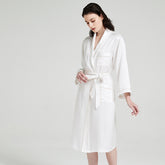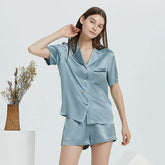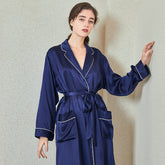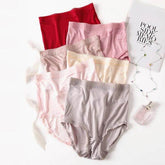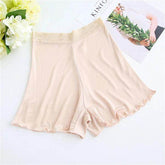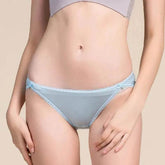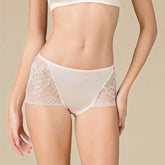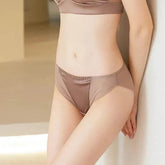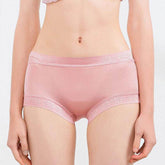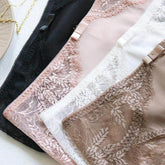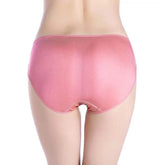The Complete Guide to Silk Pillowcases: How They Transform Your Hair Overnight
1. Introduction: The Secret to Transformed Hair Overnight
We've all experienced it—that frustrating moment when you look in the mirror after a night's sleep to find your hair resembling a bird's nest rather than the smooth, manageable locks you had the night before. The culprit might be hiding in plain sight: your cotton pillowcase.
Night after night, as you toss and turn in bed, your hair experiences significant friction against traditional cotton pillowcases. This friction leads to tangles, breakage, and that disheveled morning appearance many struggle with. Meanwhile, cotton absorbs the natural oils your scalp produces, leaving your hair depleted of necessary moisture by morning.
Silk pillowcases offer a revolutionary solution to these common hair concerns. Unlike cotton, silk creates minimal friction against your hair, allowing strands to glide across the surface without catching or tangling. The natural protein fibers of 100% mulberry silk maintain a critical balance—they don't strip your hair of essential moisture yet prevent the buildup of oils that can weigh hair down.
The transformation happens while you sleep, requiring no additional time in your beauty routine. Simply rest your head on a silk pillowcase and wake up to:
- Noticeably reduced frizz and fewer tangles
- Enhanced moisture retention and natural shine
- Less breakage and split ends over time
- Preserved styling, whether curls, waves, or blowouts
For anyone seeking healthier hair without adding complex steps to their routine, silk pillowcases provide an effortless yet effective solution that works as you rest.

1.1 What Happens to Your Hair While You Sleep?
Every night, your hair undergoes stress you might not realize. During those 7-8 hours of sleep (about 3,000 hours annually), your hair experiences:
Friction damage occurs when hair strands rub against the rough surface of cotton pillowcases, causing the hair cuticle to become raised and damaged. This friction disrupts the natural layered structure of your hair shaft, creating the perfect conditions for tangles and frizz to form by morning.
Moisture transfer happens simultaneously as cotton, a highly absorbent material, draws out the natural oils from your hair. This process leaves your hair dry and brittle, particularly affecting those with curly, coarse, or color-treated hair who already battle dryness.
Cotton pillowcases also create static electricity through this constant friction, further contributing to flyaways and that characteristic "morning hair" many dread facing in the mirror.

2. What Makes Silk Pillowcases Unique?
Silk stands apart from other fabrics through its natural composition and physical properties. True silk consists of natural protein fibers produced by silkworms, creating a structure remarkably similar to human hair. This protein-based composition allows silk to interact with hair differently than plant-based fibers like cotton or synthetic alternatives.
| Feature | Silk | Cotton | Satin |
|---|---|---|---|
| Composition | Natural protein fiber | Natural plant fiber | Synthetic weave |
| Surface Texture | Extremely smooth (microscopic scales lie flat) | Rough with protruding fibers | Smooth but often with synthetic feel |
| Moisture Management | Minimally absorbent (maintains 10-30% moisture) | Highly absorbent (wicks away moisture) | Variable depending on materials |
| Temperature Regulation | Natural temperature balancing | Absorbs heat | Often retains heat |
| Durability with Proper Care | 5-10 years | 2-3 years | 1-5 years depending on quality |
| Cost Range | $50-$150 | $5-$30 | $15-$50 |
The molecular structure of silk contains 18 amino acids and natural proteins that create an exceptionally smooth surface at the microscopic level. Unlike cotton, which has rough, irregular fibers that catch on hair, silk allows hair to move freely across its surface without creating tension or friction.
This fundamental difference explains why hair responds so differently to silk compared to other pillowcase materials, regardless of thread count or softness to the touch.

2.1 Mulberry Silk: The Gold Standard
Mulberry silk represents the highest quality silk available, comprising over 90% of silk produced worldwide. This premium silk comes from Bombyx mori silkworms that feed exclusively on mulberry leaves, creating several distinct advantages:
- Superior fiber length: Mulberry silk contains the longest continuous fibers (1,000-1,500 yards per cocoon) compared to other silk varieties, resulting in smoother fabric with fewer potential snag points.
- Consistent color and texture: The controlled diet of mulberry leaves produces silk with uniform color and exceptional smoothness.
- Higher protein content: Contains sericin, a natural protein that helps regulate moisture and provides antimicrobial properties.
When compared to other silk varieties:
- Tussah silk (wild silk) has shorter fibers (250-500 yards per cocoon) with a more textured feel
- Eri silk offers greater durability but less smoothness
- Muga silk provides golden color but less consistency in texture
The momme weight (similar to thread count) of mulberry silk typically ranges from 19-25 momme, with 22 momme offering the optimal balance of durability and softness for pillowcases. This measurement indicates the silk's density and quality—higher numbers signify greater quality and longevity.

3. Benefits of Silk Pillowcases for Hair
3.1 Reduced Friction: The Key to Preventing Breakage
Silk fundamentally changes how your hair interacts with your pillowcase during sleep. The smooth, flat fibers create a frictionless surface that allows hair to glide freely without catching or pulling. This reduced friction directly protects your hair's cuticle layer—the outermost protective layer made of overlapping scales.
When the cuticle layer remains intact and flat, hair maintains its natural strength and resilience. Scientific testing has demonstrated that hair experiences 43% less friction on silk compared to cotton surfaces. This difference becomes particularly significant over time, as the average person spends 20,000 hours with their hair in contact with pillowcases over five years.
For people with fine or fragile hair, this friction reduction translates to measurably less breakage. Hair specialists observe that clients who switch to silk pillowcases typically report seeing fewer broken hairs in their brushes and on their pillows within 2-3 weeks.

3.2 Moisture Retention: Hydration Through the Night
Unlike cotton, which can absorb up to 27% of its weight in moisture, silk absorbs only 11% while still allowing proper airflow. This critical difference means silk maintains your hair's natural moisture balance rather than depleting it.
The protein structure of silk contains amino acids that interact favorably with the keratin in your hair, creating a moisture equilibrium. Silk draws away excess oils that might weigh hair down while preventing the complete moisture loss that leads to dryness and brittleness.
Hair specialists have found this moisture retention particularly beneficial for:
- Color-treated hair, which retains vibrant color 25% longer
- Chemically processed hair recovering from treatments
- Naturally dry or porous hair types that struggle with hydration
Many users report their need for deep conditioning treatments decreases after switching to silk pillowcases, as their hair maintains natural moisture levels more effectively.

3.3 Tangle-Free Mornings: Smoother Hair with Less Effort
The friction-reducing properties of silk directly translate to significantly fewer tangles upon waking. As hair slides across silk rather than catching on cotton fibers, strands remain more aligned throughout the night, regardless of how much you move.
"Before switching to silk, I spent at least five minutes every morning detangling my shoulder-length wavy hair," reports longtime LANI SILK customer Maya T. "Now I wake up with my hair nearly as smooth as when I went to bed, cutting my morning routine in half."
This tangle prevention creates a cumulative benefit: less need for brushing and detangling means less mechanical damage to hair over time. Many users find their overall hair health improves simply because they're manipulating and pulling at it less frequently.
For parents, silk pillowcases can transform morning routines with children, reducing painful detangling sessions and tears before school—a benefit numerous customers have highlighted in their feedback.
3.4 Prolonged Hairstyles: Extending Your Look
Hairstyles that require time and effort—from professional blowouts to carefully crafted curls—maintain their shape significantly longer on silk pillowcases. The physics behind this benefit involves both reduced friction and proper moisture balance.
Curly hair maintains definition because curls aren't disrupted by catching on rough cotton fibers. Blow-dried styles last longer because silk doesn't create the friction that breaks down the hydrogen bonds set during styling. The proper moisture balance prevents both the frizz caused by dryness and the flatness caused by excess oil absorption.
Styling professionals recommend these techniques to maximize style preservation with silk pillowcases:
- Apply a light setting spray before bed for extra hold without stickiness
- Use a loose silk scrunchie to position hair above the pillow for voluminous styles
- For curly styles, arrange curls carefully on the silk pillowcase rather than bunching them
For special occasions, sleeping on silk the night before can provide a smoother foundation for styling, reducing prep time and improving results.
4. Who Benefits Most from Silk Pillowcases?
While everyone's hair can improve with silk pillowcases, certain hair types show particularly dramatic results:
Curly and textured hair experiences the most visible transformation with silk pillowcases. The natural curl pattern remains intact overnight rather than becoming disrupted by cotton's friction. Many curly-haired users report a 60-70% reduction in morning frizz and significantly improved curl definition that lasts throughout the day after switching to silk.
Fine hair benefits from silk's gentle surface that prevents the breakage fine strands are susceptible to. Users with fine hair typically notice less flattening and improved volume retention, as silk doesn't compress hair the way cotton does. The reduced oil absorption also helps fine hair maintain body rather than becoming limp.
Color-treated hair maintains vibrancy longer with silk pillowcases. The reduced friction means less color pigment gets stripped away during sleep. Studies show color molecules remain in the hair shaft 30% longer when regularly using silk pillowcases compared to cotton ones.
Aging hair, which becomes more fragile and dry with time, responds particularly well to silk's protective properties. Many users over 50 report significant improvements in hair thickness and reduced breakage within months of making the switch.
For those with extensions or weaves, silk pillowcases prevent the tension and pulling that can loosen attachments or create stress at connection points, extending the life of expensive hair investments.
4.2 Skin Benefits as a Bonus
While hair transformation remains the primary focus, silk pillowcases provide significant skin benefits worth noting. The same properties that protect hair also nurture skin:
Silk minimizes sleep creases and wrinkles by reducing friction against facial skin. The smooth surface allows skin to glide across the pillowcase rather than bunch and crease. Many dermatologists now recommend silk pillowcases as part of anti-aging routines for this reason.
The fabric's moisture-balancing properties maintain skin hydration while still allowing proper airflow. This balance proves especially beneficial for those with acne-prone skin, as silk doesn't trap oils against the skin like synthetic materials can.
For those who apply nighttime skincare products, silk absorbs significantly less product than cotton (which can absorb up to 70% of applied serums). This means your valuable skincare ingredients remain on your face rather than on your pillowcase.

5. The Science Behind Silk's Beauty Benefits
The beauty benefits of silk pillowcases extend beyond anecdotal evidence—scientific research confirms their effectiveness. A 2018 study in the Journal of Cosmetic Dermatology measured friction coefficients between human hair and various fabrics, finding that silk produced 40% less friction than cotton. This reduced friction directly correlates with cuticle protection and breakage prevention.
"The structure of silk fibers creates a fundamentally different interaction with hair compared to cotton," explains Dr. Melissa Wong, dermatologist specializing in hair disorders. "Silk's protein structure interacts harmoniously with hair's keratin proteins, while cotton's cellulose structure creates resistance and friction."
Hair microscopy studies reveal that hair strands exposed to repeated contact with cotton show measurable cuticle damage after just 30 days, while those exposed to silk maintain cuticle integrity. This difference becomes particularly significant with cumulative exposure over months and years.
The amino acid composition of silk closely resembles that of human hair, containing glycine, alanine, serine, and other proteins that create compatibility at the molecular level. This similarity explains why hair responds differently to silk than to other seemingly smooth fabrics like satin.
For those concerned with both hair and skin health, research from sleep specialists confirms that silk pillowcases reduce trans-epidermal water loss during sleep by 25% compared to cotton, helping maintain both skin and hair hydration throughout the night.

6. How to Choose the Right Silk Pillowcase
Selecting the optimal silk pillowcase requires understanding several key quality indicators:
| Feature | Recommendation | Why It Matters |
|---|---|---|
| Momme Weight | 19-25 momme (22 ideal) | Indicates silk density; lower momme silk (below 19) lacks durability while higher momme (above 25) can feel heavy |
| Silk Type | 100% Mulberry silk | Offers longest, most uniform fibers with optimal smoothness and durability |
| Closure Type | Hidden zipper or envelope | Prevents pillowcase shifting during sleep; zipper offers security while envelope closure eliminates hard components |
| Size | Slightly larger than pillow | Allows for minor shrinkage after washing and ensures complete coverage |
| Certification | OEKO-TEX Standard 100 | Verifies absence of harmful substances and ethical production standards |
Beyond these specifications, consider these factors when making your selection:
Charmeuse weave provides the smoothest surface for hair, though some prefer habotai weave for its lighter feel in warmer climates. The weave pattern significantly affects how the silk interacts with your hair, with tight, consistent weaves offering the best protection.
If ethical considerations factor into your purchase decision, peace silk (also called ahimsa silk) allows the silkworm to complete its lifecycle and emerge from the cocoon before harvesting, though this process results in shorter fibers and potentially more texture.
For those with sensitivities, undyed natural white silk offers the purest option, eliminating potential reactions to dyes. However, high-quality silk dyed using natural methods provides equally safe options with aesthetic variety.

7. Caring for Your Silk Pillowcase
Proper maintenance ensures your silk pillowcase continues delivering hair benefits for years. Follow these care guidelines:
- Wash every 7-10 days using lukewarm water (80-85°F or 27-29°C) to remove oil buildup without damaging fibers.
- Use a pH-neutral, silk-specific detergent free of enzymes, bleach, and optical brighteners that can damage protein fibers.
- Hand wash by gently agitating for 2-3 minutes without wringing or twisting, which can break silk fibers.
- If machine washing, place inside a mesh laundry bag, select a delicate cycle, and use a silk-safe detergent.
- Air dry flat on a clean towel away from direct sunlight, which can weaken fibers and cause color fading.
- Store folded in a drawer rather than hanging to prevent stretching the fibers.
Avoid these common mistakes that damage silk pillowcases:
Never use fabric softeners, which coat fibers and reduce silk's natural benefits. Skip hot water washing or drying, as temperatures above 86°F (30°C) can damage protein structures in silk. Keep silk away from face products containing benzoyl peroxide or strong acids, which can weaken the fibers and cause discoloration.
With proper care, a high-quality silk pillowcase should maintain its benefits for 3-5 years before showing signs of wear that might diminish its hair-protecting properties.
8. Real-Life Transformations: User Testimonials
The impact of switching to silk pillowcases reveals itself in these experiences from LANI SILK customers:
"After coloring my hair for 15 years, I was resigned to fading and dryness between salon visits. Three weeks after switching to my silk pillowcase, my stylist asked what products I had changed—the color was holding that much better. I hadn't changed anything except my pillowcase!" — Jessica M., naturally curly, color-treated hair
"As someone with fine, straight hair that turns into a tangled mess overnight, I was skeptical about silk pillowcases making a difference. The change was immediate—I wake up with smooth hair that needs minimal brushing, and I've noticed significantly less breakage around my hairline." — Michael T., fine hair texture
"Managing my daughter's 4C hair used to make mornings a battle of tears and frustration. Since getting her a silk pillowcase, her hair stays moisturized and defined overnight. Morning routines are peaceful now, and her hair health has visibly improved." — Tiana J., parent
"After radiation treatment left my hair fragile and prone to breakage, my oncologist actually recommended silk pillowcases. They've been crucial to protecting my new growth and minimizing the breakage during recovery." — Susan L., recovering from medical hair loss
9. Comparative Insights: Silk vs Satin Pillowcases
While often confused, silk and satin differ fundamentally—silk is a fiber, while satin is a weave pattern that can be created using various fibers. This distinction significantly impacts performance:
| Aspect | 100% Mulberry Silk | Polyester Satin |
|---|---|---|
| Fiber Origin | Natural protein from silkworms | Synthetic petroleum-based product |
| Hair Benefits | Superior friction reduction and moisture balance | Moderate friction reduction, no moisture regulation |
| Breathability | Naturally temperature-regulating | Often traps heat |
| Longevity | 3-5 years with proper care | 1-2 years before developing roughness |
| Environmental Impact | Biodegradable | Non-biodegradable |
| Price | $50-$150 | $15-$40 |
While polyester satin provides some friction reduction benefits at a lower price point, it lacks silk's protein structure that interacts favorably with hair. Satin pillowcases typically begin losing their smoothness after 30-40 washes, at which point the friction-reducing benefits diminish significantly.
Some "silk-alternative" fabrics claim similar benefits, but microscopic testing reveals fundamental differences in fiber structure that affect performance. The amino acids naturally present in silk create benefits that synthetic alternatives cannot replicate.
10. Expanding Your Beauty Routine with Silk Accessories
For those who experience the benefits of silk pillowcases, additional silk accessories can extend these advantages throughout your beauty routine:
Silk scrunchies prevent the creasing and breakage caused by elastic hair ties. The smooth surface distributes tension evenly without creating stress points in the hair shaft. Many users find these particularly beneficial for holding ponytails overnight without creating kinks or damage.
Silk sleep caps offer full hair protection, especially for complex styles or very curly hair. They keep moisture in while preventing friction against both pillowcases and bedroom air, which can contain drying elements, particularly in homes with forced-air heating or cooling.
Silk eye masks provide skin benefits for the delicate eye area while blocking light for improved sleep quality. The gentle pressure without friction helps minimize morning puffiness and preserves delicate skin.
Together, these silk elements create a comprehensive system that protects hair and skin throughout the night, maximizing the regenerative benefits of sleep for your appearance.
11. Addressing Common Concerns
Affordability: "Are there budget-friendly silk options?" While quality silk represents an investment, consider starting with a standard size pillowcase rather than a complete set. The concentrated benefits for hair justify prioritizing this purchase. Some find that the reduced need for styling products and heat tools after switching to silk actually creates cost savings over time.
Allergies: "Can silk cause skin reactions?" True silk allergies are extremely rare. Many people who believe they have silk allergies are actually reacting to dust mites or processing chemicals. Look for undyed silk with OEKO-TEX certification to eliminate potential irritants. Natural silk actually contains properties that repel dust mites, making it hypoallergenic for most users.
Authenticity: "How can I verify I'm getting real silk?" True silk feels cool to the touch initially but warms quickly. The burn test (burning a small thread) produces a smell like burning hair rather than melting plastic. Reputable manufacturers like LANI SILK provide certification of authenticity and momme weight to verify quality.
Temperature: "Will silk make me too hot or cold?" Silk naturally regulates temperature by wicking moisture while providing insulation when needed. It adapts to body temperature, feeling cool in warm weather and warm in cool weather—a quality synthetic fabrics cannot replicate.
12. Conclusion: Wake Up to Better Hair Every Morning
The transformation a silk pillowcase brings to your hair occurs without effort, special techniques, or additional time in your routine. Simply rest your head and allow silk's natural properties to protect and nurture your hair throughout the night.
The investment in a quality silk pillowcase pays dividends in reduced damage, enhanced natural beauty, and simplified morning routines. For anyone who values hair health—whether managing curls, preserving color, protecting fragile strands, or simply waking up with smoother, more manageable hair—silk pillowcases provide a passive yet powerful solution.
Experience what thousands have discovered: the simple switch to silk creates cumulative benefits that transform hair health over time. Your journey to consistently better hair days begins tonight, with something as fundamental as changing your pillowcase.
Explore LANI SILK's collection of premium mulberry silk pillowcases, crafted with 22 momme weight silk in a variety of colors to complement both your bedroom decor and beauty routine. Your hair deserves this nightly luxury that delivers real results by morning.
Frequently Asked Questions
Do silk pillowcases work for straight hair? Yes, straight hair benefits significantly from silk pillowcases. The reduced friction prevents tangles and breakage, while the moisture balance keeps straight hair from appearing flat or greasy by morning. Many straight-haired users report improved shine and volume after switching to silk.
How quickly will I notice a difference in my hair? Most users notice reduced tangles and frizz immediately (after the first night). More substantial benefits like decreased breakage and improved overall hair health typically become apparent after 2-3 weeks of consistent use.
Can silk pillowcases replace hair products? While silk pillowcases enhance hair health, they work best as part of a complete hair care routine. They reduce the need for anti-frizz products and heat styling, but they don't eliminate the need for proper conditioning and protection.
Will a silk pillowcase help with hair loss? Silk pillowcases reduce breakage through friction reduction, which can make hair appear fuller and healthier. While they cannot address hormonal or genetic hair loss, they help preserve the hair you have by minimizing mechanical damage during sleep.
